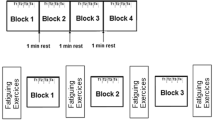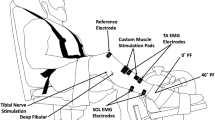Abstract
The aim of this study was to examine the post-exercise effects of fatiguing the wrist extensor muscles of a single arm on postural tremor and muscle activity in both arms. Previous research has shown that, for neurologically normal subjects, the tremor seen within a single limb segment is uncorrelated to that seen contralaterally. However it has been speculated that some bilateral relation does exist, and that the nature of the relation may only become evident under conditions where the neuromuscular system is perturbed. To further investigate this potential bilateral relation, seven healthy subjects were required to adopt a bilateral postural pointing position after exercise-induced fatigue of the wrist extensor muscles of a single arm. Tremor from the forearm, hand and finger segments of each arm, surface EMG activity from extensor digitorum (ED) of each arm, and blood lactate data were collected prior to and after the exercise intervention. The main result was that fatiguing the distal muscles of one arm resulted in a bilateral increase in both the physiological tremor and ED activity. The change in tremor was confined to the index finger with no change in the tremor for the hand or forearm segments of either arm. While three peaks were seen in the frequency profile of the finger tremor, the effects of fatigue were confined to an increase in the peak power of the neurally generated 8–12 Hz tremor component. The contralateral increase in muscle activity was also reflected by a change in the frequency profile of the EMG output, with an increase in the peak power of both muscles following exercise of the wrist extensors of a single arm. The bilateral increases in physiological tremor and EMG activity of ED were only observed during the bilateral pointing task, with no changes in tremor or EMG activity seen for the non-exercised limb during the unilateral exercise protocol. The specificity of the resultant increases in the neurally generated 8–12 Hz component of finger tremor amplitude and EMG activity, coupled with the lack of any changes in tremor for the more proximal arm segments, indicate that these bilateral effects were mediated by an increase in the central neural drive to both limbs. Together this set of results challenges the general assumption of bilateral independence of tremor production, and further illustrate the task dependent nature of exercise-induced fatigue.






Similar content being viewed by others
References
Arblaster L, Lakie M (1990) Simultaneous bilateral recording of human tremor. J Physiol 420:6
Arblaster L, Lakie M, Walsh E (1990) Human physiological tremor: a bilateral study. J Physiol 429:132
Arihara M, Sakamoto K (1999) Contribution of motor unit activity enhanced by acute fatigue to physiological tremor of finger. Electromyogr Clin Neurophysiol 39:235–247
Bernstein N (1967) The coordination and regulation of movement. Pergamon, Oxford
Bousfield WA (1932) The influence of fatigue on tremor. J Exp Psychol 15:104–107
Cresswell AG, Loscher WN (2000) Significance of peripheral afferent input to the alpha-motoneurone pool for enhancement of tremor during an isometric fatiguing contraction. Eur J Appl Physiol 82:129–136
De Luca CJ (1997) The use of surface electromyography in biomechanics. J Appl Biomech 13:135–163
Ebenbichler GR, Kollmitzer J, Erim Z, Loscher WN, Kerschan K, Posch M, Nowotny T, Kranzl A, Wober C, Bochdansky et a (2000) Load-dependence of fatigue related changes in tremor around 10 Hz. Clin Neurophysiol Official J Int Fed Clin Neurophysiol 111:106–111
Elble RJ (1996) Central mechanisms of tremor. J Clin Neurophysiol 13:133–144
Elble RJ, Koller WC (1990) Tremor. Johns Hopkins, Baltimore
Elble RJ, Randall JE (1976) Motor-unit activity resposible for 8- to 12-Hz component of human physiological finger tremor. J Neurophysiol 39:370–383
Elble RJ, Randall JE (1978) Mechanistic components of normal hand tremor. Electroencephalogr Clin Neurophysiol 44:72–82
Enoka RM (1995) Mechanisms of muscle fatigue: central factors and task dependency. J Electromyogr Kinesiol 5:141–149
Enoka RM, Stuart DG (1992) Neurobiology of muscle fatigue. Journal Of Applied Physiology (Bethesda, Md.: 1985) 72:1631–1648
Gajewski J, Viitasalo JT (1994) Does the level of adaptation to a heavy physical effort influence fatigue-induced changes in tremor amplitude? Hum Mov Sci 13:211–220
Gandevia SC (1998) Neural control in human muscle fatigue: changes in muscle afferents, motoneurones and motor cortical drive. Acta Physiol Scand 162:275–283
Gandevia SC (2001) Spinal and supraspinal factors in human muscle fatigue. Physiol Rev 81:1725–1789
Gladden LB (2004) Lactate metabolism: a new paradigm for the third millennium. J Physiol 558:5–30
Halliday AM, Rosenberg JR, Amjad AM, Breeze P, Conway BA, Farmer SF (1995) A framework for the analysis of mixed time series/point process data - theory and application to the study of physiological tremor, single motor unit discharges and electromyograms. Prog Biophys Mol Biol 64:237–278
Halliday A, Conway B, Farmer S, Rosenberg J (1999) Load-independent contributions from motor unit synchronization to human physiological tremor. J Neurophysiol 82:664–675
Kent-Braun JA (1999) Central and peripheral contributions to muscle fatigue in humans during sustained maximal effort. Eur J Appl Physiol Occup Physiol 80:57–63
Keogh J, Morrison S, Barrett R (2004) Augmented visual feedback increases finger tremor during postural pointing. Exp Brain Res 159:467–477
Lippold O (1970) Oscillation in the stretch reflex arc and the origin of the rhythmical 8–12 component of physiological tremor. J Physiol (Lond) 206:359–382
Lippold O (1981) The tremor in fatigue. Ciba Found Symp 82:234–248
Llinas R (1984) Possible role of tremor in the organisation of the nervous system. In: Findley L, Capildeo R (eds) Movement disorders: tremor. Butterworth, London, pp 475–477
Llinas RR (1991) The noncontinuous nature of movement execution. In: Humphrey DR, Freund H-J (eds) Motor control: concepts and issues. Wiley-Interscience, New York, pp 223–242
Llinas R, Pare D (1997) Role of intrinsic neuronal oscillations and network ensembles in the genesis of normal and pathological tremors. In: Findley LJ, Koller WC (eds) Handbook fo tremor disorders. Marcel Dekker, New York
Marsden C (1984) Origins of normal and pathological tremor. In: Findley L, Capildeo R (eds) Movement disorders: tremor. Butterworth, London, pp 37–84
Marsden C, Meadows J, Lange G, Watson R (1969) The relation between physiological tremor of the two hands in healthy subjects. Electroencephalogr Clin Neurophys 27:179–185
McAuley J, Rothwell J, Marsden C (1997) Frequency peaks of tremor, muscle vibration and electromyographic activity at 10 Hz, 20 Hz and 40 Hz during human finger muscle contraction may reflect rhythmicities of central neural firing. Exp Brain Res 114:525–541
Morrison S, Newell K (1996) Inter- and intra-limb coordination in arm tremor. Exp Brain Res 110:455–464
Morrison S, Newell K (1999) Bilateral organization of physiological tremor in the upper limb. Eur J Appl Physiol Occup Physiol 80:564–574
Morrison S, Newell K (2000) Postural and resting tremor in the upper limb. Clin Neurophysiol 111:651–663
Palmer SS (1991) Changes in finger tremor during prolonged submaximal contractions. Hum Mov Sci 10:677–688
Proudlock FA, Scott J (2003) Tremor in the human hand following peripheral nerve transection and reinnervation. Brain Res 989:238–245
Saxton JM, Clarkson PM, James R, Miles M, Westerfer M, Clark S, Donnelly AE (1995) Neuromuscular dysfunction following eccentric exercise. Med Sci Sports Exerc 27:1185–1193
Shinohara M, Keenan KG, Enoka RM (2003) Contralateral activity in a homologous hand muscle during voluntary contractions is greater in old adults. J Appl Physiol (Bethesda, Md.: 1985) 94:966–974
Stein R, Lee R (1981) Tremor and Clonus. In: Brooks V (ed) Handbook of physiology. Motor control. American Physiological Society, Bethesda, pp 325–343
Stiles RN (1980) Mechanical and neural feedback factors in postural hand tremor of normal subjects. J Neurophysiol 44:40–59
Stiles RN, Pozos RS (1976) A mechanical-reflex oscillator hypothesis for parkinsonian hand tremor. J Appl Physiol 40:990–998
Stiles RN, Randall JE (1967) Mechanical factors in human tremor frequency. J Appl Physiol 23:324–330
Taylor JL, Butler JE, Gandevia SC (2000) Changes in muscle afferents, motoneurons and motor drive during muscle fatigue. Eur J Appl Physiol 83:106–115
Todd G, Petersen NT, Taylor JL, Gandevia SC (2003) The effect of a contralateral contraction on maximal voluntary activation and central fatigue in elbow flexor muscles. Exp Brain Res 150:308–313
Vaillancourt DE, Newell KM (2000a) Amplitude changes in the 8–12, 20–25, and 40 Hz oscillations in finger tremor. Clin Neurophysiol 111:1792–1801
Vaillancourt DE, Newell KM (2000b) The dynamics of resting and postural tremor in Parkinson’s disease. Clin Neurophysiol 111:2046–2056
Vaillancourt DE, Newell, K.M. (2000) Amplitude changes in the 8–12, 20–25, and 40 Hz oscillations in finger tremor. Clin Neurophysiol 111:1792–1801
Vaillancourt DE, Larsson L, Newell KM (2003) Effects of aging on force variability, single motor unit discharge patterns, and the structure of 10, 20, and 40 Hz EMG activity. Neurobiol Aging 24:25–35
Viitasalo JT, Gajewski J (1994) Effects of Strength training-induced fatigue on tremor spectrum in elbow flexion. Hum Mov Sci 13:129–141
Viitasalo JT, Gajewski J, Wit A (1994) Forearm tremor during three different isometric loadings. Electromyogr Clin Neurophysiol 34:131–136
Vollestad NK, Sejersted OM, Bahr R, Woods JJ, Bigland-Ritchie B (1988) Motor drive and metabolic responses during repeated submaximal contractions in humans. J Appl Physiol (Bethesda, Md.: 1985) 64:1421–1427
Wessberg J, Vallbo AB (1995) Coding of pulsatile motor output by human muscle afferents during slow finger movements. J Physiol 485:271–282
Wessberg J, Vallbo AB (1996) Pulsatile motor output in human finger movements is not dependent on the stretch reflex. J Physiol 493(Pt 3):895–908
Zijdewind I, Kernell D (2001) Bilateral interactions during contractions of intrinsic hand muscles. J Neurophysiol 85:1907–1913
Zijdewind C, Bosch W, Goessens L, Kandou TW, Kernell D (1990) Electromyogram and force during stimulated fatigue tests of muscles in dominant and non-dominant hands. Eur J Appl Physiol Occup Physiol 60:127–132
Zijdewind I, Zwarts MJ, Kernell D (1998) Influence of a voluntary fatigue test on the contralateral homologous muscle in humans? Neurosci Lett 253:41–44
Author information
Authors and Affiliations
Corresponding author
Rights and permissions
About this article
Cite this article
Morrison, S., Kavanagh, J., Obst, S.J. et al. The effects of unilateral muscle fatigue on bilateral physiological tremor. Exp Brain Res 167, 609–621 (2005). https://doi.org/10.1007/s00221-005-0050-x
Received:
Accepted:
Published:
Issue Date:
DOI: https://doi.org/10.1007/s00221-005-0050-x




